Realign Gift Officer Metrics in the COVID-19 Era
Higher education has been strained by COVID-19 in unprecedented ways. Institutional leaders are being forced to slash budgets across the board after a decade of historic investment in advancement. Chief advancement officers are being left with limited resources and sky-high expectations to fill the institutional budget shortfalls caused by the pandemic.
Exacerbating the situation, advancement leaders anticipate that COVID-19 will continue posing a challenge to fundraising across FY2021. They have expressed fear that expectations from presidents and boards are unrealistic given the economic realities facing many donors. Across the sector, advancement leaders are asking what goals are reasonable for them to set for their teams, and which metrics to track to help them get there amidst a new landscape.
Despite these hurdles, college and university advancement has been presented with an opportunity to strategically realign metrics with what matters most and to better support development officers with goals and leading indicators to keep them on track.
This white paper from the Advancement Forum is organized into three sections:
Advancement’s Growing Revenue Pressures
Review this section to see the contrast between president and board plans to weather the current budgetary crisis with advancement’s reality of a tough fundraising year ahead.
Optimizing Gift Officer Performance Goals
Use the data in this section to compare changes you’ve made to your shop’s revenue, proposal, and qualification goals to other shops across North America.
Redesigning Metrics Systems to Drive Productivity
Explore practices in this section to identify creative ways to better align your metrics to shifting institutional priorities.
Advancement’s Growing Revenue Pressures
Sky-High Expectations from Senior Leadership: Advancement Must Fill Mounting Budget Shortfalls
As the COVID-19 crisis persists, colleges and universities face widening budget gaps that, in some cases, threaten their very existence. In this climate, every dollar of revenue is critical.
Consequentially, senior institutional leaders have not backed off on goals for fundraising. They are depending on advancement leaders to fill budgetary gaps exacerbated by the pandemic.
When Inside Higher Ed polled presidents to ask how they plan to manage budget shortfalls, the top response was “cultivate new donor bases.” On top of that, about half of the presidents in the survey said they intended to start or expand a capital campaign.
% of Presidents Likely to Take Each Action to Manage Budget Shortfall
(Inside Higher Ed, April 2020)
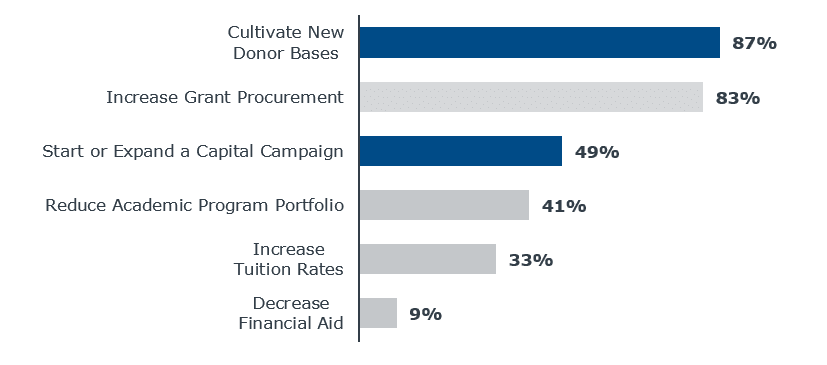
Similarly, in a survey EAB of over 100 advancement leaders, three-quarters reported that senior leaders at their institutions expect fundraising performance in FY2021 to stay the same or increase as compared to FY2020.
75%
Expectations Misaligned with Advancement’s Reality: Chief Advancement Officers Report Bleak Fundraising Outlook
Senior leaders’ expectations do not always align with the goals that CAOs think are realistic for their teams.
When EAB polled chief advancement officers about their FY2021 fundraising outlook, 65%—nearly two-thirds—said they were anticipating revenue declines. 41% reported expecting double-digit declines in the value of new gifts and commitments.
Projected Decline in Value of New Commitments, FY2021
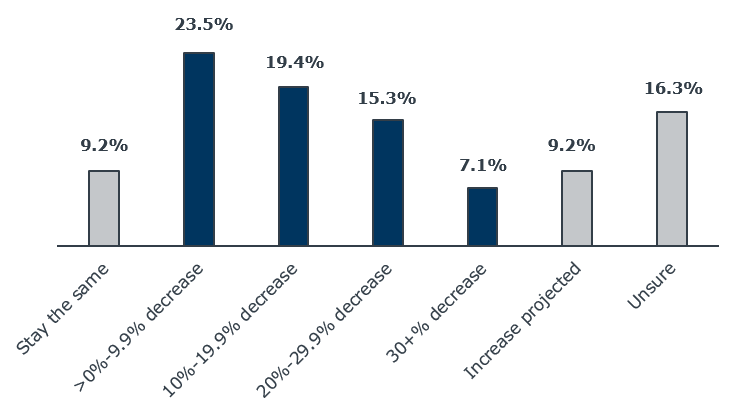
Advancement leaders anticipate the first half of FY2021 to be especially challenging, with 77% anticipating COVID-19 will have a medium to high impact on fundraising through the end of December.
COVID-19 Impact on Fundraising Over the Next 90 Days
(GG+A, September 2020)
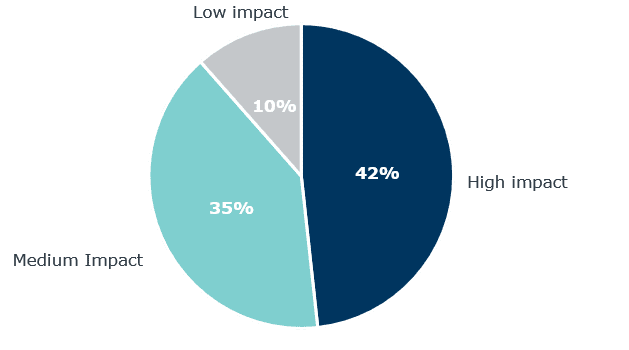
Heightened expectations from senior leaders leave little margin for error when it comes to development officer performance. Small differences in productivity can have an outsized impact on fundraising figures, making it even more important to ensure development officers achieve their potential.
The remainder of this white paper will focus on how college and university advancement leaders are using metrics systems to drive fundraiser performance and meet these outsized expectations.
Optimizing Gift Officer Performance Goals
A Bearish Outlook on Dollar Goals: Despite Presidents’ Ambitions, CAOs Set Modest Frontline Revenue Goals
Although most senior institutional leaders have adopted optimistic outlooks for FY2021 fundraising performance, chief advancement officers must tread more carefully with their frontline fundraising teams.
Setting unrealistic goals can cause burn-out and disengagement, further depressing returns. Yet at the same time, aiming too low will prove demotivating to competitive, goal-driven fundraisers who seek a challenge.
Across August and September 2020, EAB surveyed advancement leaders to explore optimal goal levels for individual fundraisers. We asked survey participants how much they were changing gift officers’ dollar, closed proposal, submitted proposal, and qualification goals in FY2021 compared to FY2020.
Change in Gift Officer Dollar Goals, FY2020 to FY2021
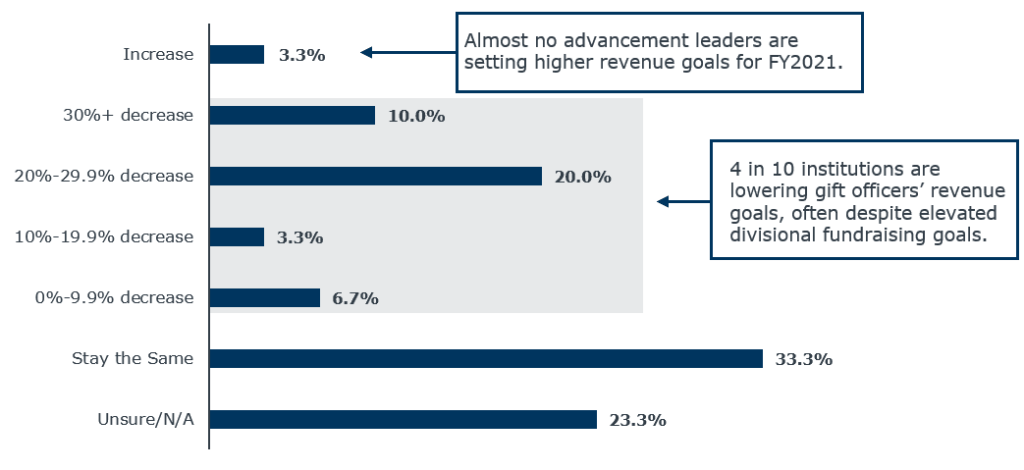
Beginning with dollar goals, EAB found that many advancement leaders were pulling back on individual revenue goals after years of increases. 40% were setting lower goals; for 33% of respondents, those goal decreases reached into the double-digits.
Among those institutions that resisted goal decreases, few set their sights higher than last year. Only 3% of survey participants said that they increased gift officers’ dollar goals compared to last year.
All told, while there hasn’t been a universal pull-back on fundraising ambitions at the individual level, we are seeing far more institutions setting modest individual goals than in any recent year.
Holding the Line on Proposals: With Revenue in Question, CAOs Encourage Proposal Discipline
Advancement leaders entered FY2021 feeling more confident about proposals than about revenue. Whereas only 33% of advancement leaders said they would keep dollar goals the same in FY2021 as in FY2020, nearly twice as many respondents (65%) reported that they maintain last year’s submitted and closed proposal goals through this fiscal year.
Change in Gift Officer Proposal Goals, FY2020 to FY2021
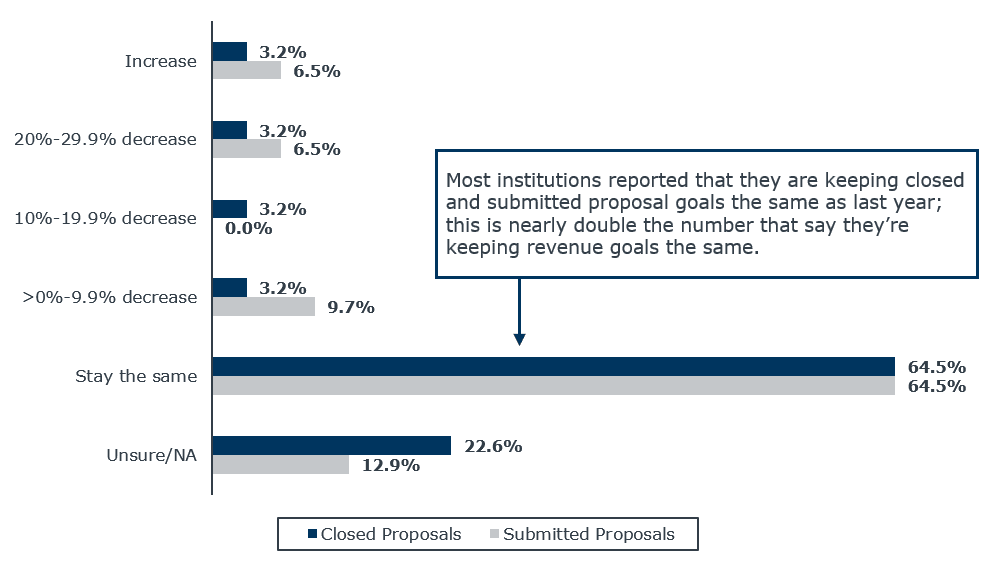
Based on EAB’s interviews with advancement leaders, this decision to hold the line on proposals comes for two reasons.
First, it reflects a strategy of prioritizing throughput over revenue. Advancement leaders suspect that many prospects, especially newer major gift donors, will lack the financial confidence in FY2021 to make a transformative investment in the institution. That doesn’t mean that gift officers should give up. By sustaining proposal submission and closure requirements, advancement leaders are encouraging their teams to get gifts over the finish line today, even if those gifts are smaller than they might have been in the absence of the pandemic.
Second, it reflects a desire to push hard on those metrics that are within advancement’s locus of control. While the size of a gift may be subject to countless environmental factors in which advancement has no say, whether gift officers are putting proposals in front of donors—and, to a lesser extent, whether they’re closing those proposals—has quite a bit to do with internal cultivation strategies and gift officer workflow management rather than just external conditions.
Cautious Optimism Surrounds Qualifications
While few institutions are asking their frontline officers to chase higher dollar and proposal goals, such is not the case for qualifications. The new, digital normal has allowed interactions with constituents to be quicker and more accessible than ever before. As a result, advancement leaders report qualifications as their team’s most ambitious goal for FY2021, with 71% reporting that these goals are staying the same or increasing—the most of any category polled.
Change in Gift Officer Qualification Goals, FY2020 to FY2021
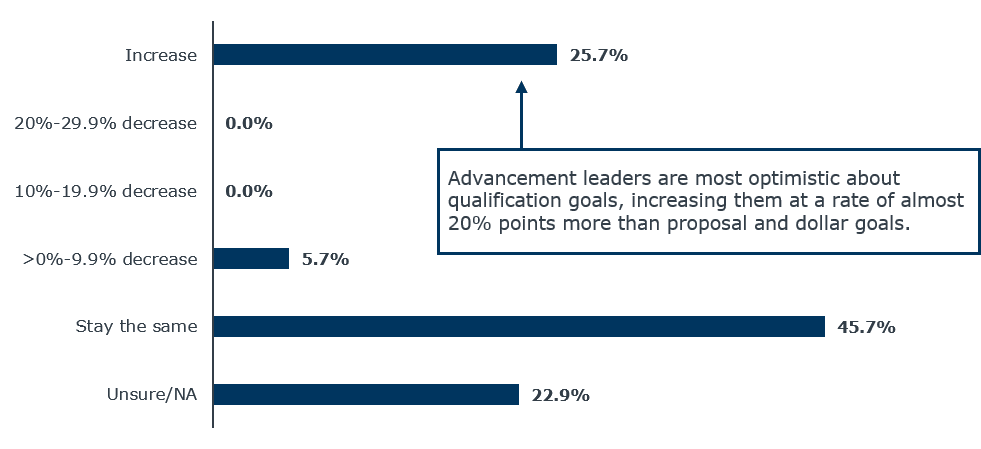
Despite the optimism for qualification, there is still a lot of uncertainty. As the pandemic continues, gift officers must compete with an ever-lowering threshold for Zoom fatigue. While they may have an easier time qualifying new prospects now, will people still want to sign up for a video meeting in 3-6 months?
This is an area where advancement shops will need to pay close attention to market conditions. Gift officers can stay ahead of this potential hurdle by varying their method of communication with prospects between email, phone, and video-conference. Prior to video-conferencing, gift officers should also proactively offer to keep video off to help combat Zoom fatigue.
Redesigning Metrics Systems to Drive Productivity
Tracking Activity in a No-Visit World: Database Changes Necessitated in Absence of In-Person Cultivation
Setting appropriate goals may not be enough to drive gift officer performance this year. The chaos, uncertainty, and disruption that our work has been subject to requires us to look more critically both at how we’ve built our metrics systems as well as how we use them.
Beyond the Visit: Capturing the Diversity of Cultivation
The in-person visit has historically been the cornerstone of the cultivation process. When COVID-19 abruptly forced us to operate in an exclusively digital manner, advancement shops reexamined the tools in their toolbox to continue cultivating donors.
Despite these innovations, many metrics systems were still set up to exclusively count and incentivize in-person visits. College and university advancement leaders have recently reconfigured their metrics systems to accommodate this diversity in the following ways.
Many institutions redefined the visit, opting to use the metric as a catch-all for a variety of interactions. Today, all prospect touches, be they phone calls, Zoom meetings, or other substantive contacts, are recorded as visits within the donor database. Often, institutions that implement this “catch-all” strategy must periodically review gift officers’ contact reports to ensure that low-value touches are not being counted erroneously.
One institution our researchers spoke with in Canada adopted a three-metric system: face-to-face visits, online contacts, and phone calls. This move has allowed them to distinguish between and accurately count different interaction types within their CRM.
At Butler University, advancement leaders scrapped visit-tracking entirely in favor of a bifurcated system of moves and touches. A move is coded as any interaction that brings donors closer to giving, while a touch encompasses all lighter interactions that serve to sustain mindshare. Now, advancement leaders can worry less about low-quality activity counting toward gift officers’ cultivation goals, since lighter touches exist in their own category.
Driving Priorities with Ad Hoc Metrics: Flexibility Is an Asset in the COVID-19 World
Tracking dollars, proposals, and visits alone may not yield the results advancement teams need to achieve. Even with those metrics, cultivation quality can suffer. Pipelines can dry up. The unrestricted coffers may go empty.
Best-practice colleges and universities have introduced new, alternative metrics in advancement in addition to more traditional ones in an effort to drive activity around core institutional priorities.
Institutional Goals Pursued through Targeted Metrics

Cross-Campus Collaboration
Institution: Ithaca College
- Goal: Increase campus partners’ participation in cultivation
- Metric: Minimum requirement that 10% of constituent contacts include another campus stakeholder
- Result: Cross-campus ownership over donor retention and relationships

New-Donor Pipelines
Institution: North Carolina State University
- Goal: Refill pipeline and increase pool coverage, especially with donors in discovery
- Metric: Prospect assignment requested (PAR), measuring qualified prospects with interest in making a gift
- Result: Projecting 128 more major gift prospects in FY21 than FY20

Unrestricted Fundraising
Institution: University of Notre Dame
- Goal: Increase unrestricted revenues
- Metric: Gift officers must raise 10%-20% of their total revenue goal in the form of unrestricted gifts
- Result: $27.5M raised in unrestricted funds from 220 gifts—an average of $125K per gift
Rotating Targeted Metrics by Season to Address Emerging Priorities
McGill University divided their fundraising year into four seasons to focus on new metrics as priorities emerge. During the summer, the team focused on pool coverage and planned giving. Fall will bring a focus on asks and annual fund leaders.
They hope this rotating will prepare gift officers for a successful next season. If they do a good job covering their pools in the summer, they will be well set up to make asks in the fall.
Using Metrics for Real-Time Performance Management: Closely Monitored KPI Dashboards Can Avert Disastrous Year-End Returns
The work of fundraising has shifted dramatically in the months since gift officers last stepped foot in their offices. Many risk losing momentum as they grapple with an ever-changing environment.
To combat this, college and university advancement leaders have begun using metrics not just as lagging indicators (through end-of-year, post-hoc evaluations), but also as leading indicators to identify red flags before it is too late.
Incentivize Gift Officers Through Real-Time Performance Feedback
Loyola University Maryland began sending out weekly scorecards featuring five metrics across the current period and fiscal year. This has created a sense of friendly competition among the team and incentivized gift officers to hit their goals.
Sample weekly scorecard for one gift officer
| Metric | Year to Date |
|---|---|
| Solicitations | 25 |
| Gifts Closed | 10 |
| Dollars Raised | $1,250,000 |
| Number of Email Contacts | 135 |
| Number of Phone Contacts | 70 |
Leverage Data to Identify the Root Cause of MGO Inefficiencies
Before the pandemic, advancement leaders at Oregon State University realized that managers need to understand the root cause of fundraiser performance. They decided to build a system whereby performance is assessed based on four metrics, but managers have access to KPI dashboards with 18 additional data points that support these metrics and help identify red flags. This gives managers the tools they need to coach their team and give gift officers immediate next steps to reach their goals.
Access our gift officer metrics tracker
This check-in template will help gift officers and managers track short-term contacts, moves, and leading indicators to assess progress toward annual goals.
This resource requires EAB partnership access to view.
Access the research report
Learn how you can get access to this resource as well as hands-on support from our experts through Advancement Advisory Services.
Learn More